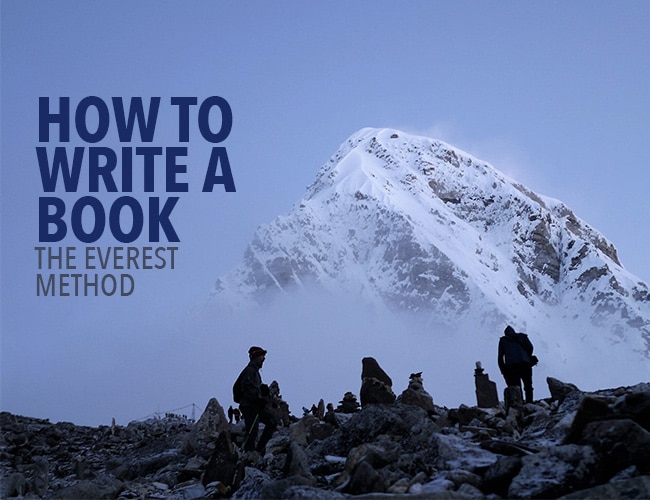Your dream of writing a book is like climbing a mountain. Not just any mountain, either: Mount Everest, the tallest peak in the world. Not convinced? Let's take a look at how to write a book using what I call the Everest Method.

Want to learn how to write a book from start to finish? Check out How to Write a Book: The Complete Guide.
Climbing the Tallest Mountain
For many folks, climbing Mt. Everest is a lifelong goal. They save up tens of thousands of dollars and devote months of their time to fly across the globe and attempt to do what fewer than 5,000 people have done in all of human history.
To scale all 29,029 feet of the peak, climbers must take many steps to ensure their success, like establish a resourceful base camp, fix ropes and ladders along the route, haul gear up the mountain, acclimatize to the altitude, and power through during the rough climbs.
For most folks, climbing Mt. Everest is not a life-long goal, but something much like it is: Writing a book.
Writing a book has many surprising similarities to climbing Mt. Everest. It's no surprise that both tasks are incredible challenges that few people can say they've accomplished.
Perhaps writing a book, or writing your next book, is the tallest mountain in your horizon.
It's time to climb it. Here's how.
How to Write a Book: The Everest Method
There are innumerable steps real alpinists take to scale towering peaks. But for simplicity's sake, they can be summarized like this:
- Establish Base Camp
- Fix Ropes and Ladders
- Haul Gear
- Acclimatize (so they don't die)
- Power Through
Each of these steps ensures that the climber will have everything he or she needs to be successful, especially when the mountain fights back and refuses to surrender her precious summit.
The same will occur for you. The book will fight back. The universe won't succumb to your desire to be creative. You'll need every resource possible to be victorious.
Here's how to write a book as though you're summiting the world's tallest mountain.
1. Establish a Resourceful Base Camp
A writer's “base camp” is his or her writing space. Do you have a quiet time and place to write? Make one. Even if your office is the end of the dining room table (like mine) and your quiet time is a pair of Apple earbuds (like mine), set up your tent wherever you can and make it your base camp.
Then fill your base camp with resources. Find two or three books that inspire you and keep them nearby. Buy your favorite coffee or tea make sure you won't run out. Keep a pad of paper or notebook close, and make sure you only use it for your book. Don't let it become the to-do list or scribbling paper for the kids.
Finally, invite a team to join you in base if you like. Join a writing community, either a live one, online one like Becoming Writer, or a coached program like the 100 Day Book Program, and share the experience with a team of eager writers who are tackling their own version of Mt. Everest.
2. Fix Ropes and Ladders
The first step of climbing Mt. Everest, via the Nepal route, is a dangerous trek through the Khumbu Icefall, a tumbling labyrinth of ice blocks the size of houses that can fall at any time. Yawning crevasses can appear at any time, and most climbing teams send groups of local Sherpa to establish ladders and ropes to make the climb much safer.
Without these ropes and ladders, 99% of non-Sherpa climbers would be helpless to get one mile outside of base camp. But with this guidance and support, climbers move through the Icefall with ease and continue upward toward the summit.
Similarly, you need guides and supports on your way. This means you need to plan ahead and outline the story you want to tell. Forging onward into the unknown of a book may sound adventurous, but you'll quickly find yourself lost and blocked if you do. You need reminders of where to go so you avoid pitfalls that could discourage you or derail the project.
Use brainstorming techniques like freewriting, clustering, bubble maps, or writing prompts to get the creative juices flowing. Then take the beginnings of the characters you dream up and start giving them goals to pursue in an interesting setting.
Finally, outline your plot by identifying major choices, not events. Event-based plotting will result in illogical story threads that you'll constantly be struggling to piece back together. But when you plot based on character choices, events are related by much clearer and believable causation, making your revision process much easier later on.
3. Haul Gear Up the Mountain
It's time to start climbing. But beyond the Khumbu Icefall is cavernous bowl between Everest and Mt. Lhotse called the Western Cwn (pronounced “coom”) that stretches up to Camp 2. It then terminates at a wall known as the Lhotse Face, leading arduously up to the higher camps and the “Death Zone” where there isn't enough oxygen to survive for very long.
It is very rare that a climber achieves the summit with minimal gear. Perhaps the most cherished piece of mountaineering equipment atop Everest is the heavy and bulky oxygen tank. And they don't get there on their own.
Climbers and their Sherpa guides (okay, mostly the Sherpa guides) have to haul each and every piece of equipment to the South Col where their final camp, Camp 4, will be staked. And it isn't easy.
When writing a novel, you thankfully don't have to haul equipment to the latter chapters of your book. But you do have to carry ideas. You have to carry details, choices, and storylines. And the burden can feel just as heavy as a fully-loaded pack on your shoulders.
Everest climbers accomplish this goal by slowly hauling one load up at a time. They don't carry it all at once. Sure, it requires a lot of trips up and down, up and down, but the work gets done.
When writing your book, you may find yourself stalled partway up. You'll feel discouraged, but this is actually a good thing. You have to turn back and figure out what you left behind.
Maybe it's some dialogue that has to be rewritten so the correct motivation can be carried onward. Maybe you have the wrong character making certain choices, and need to go back so the proper character is taking these actions.
Go up. Go down. Go up a little more. Go back down.
It's how Everest is climbed, and it's how many novels are written.
4. Acclimatize . . . and Don't Die
Most people live below 10,000 feet. That's for a good reason. Above 10,000 feet, most humans experience signs of Acute Mountain Sickness (AMS), including dizziness, nausea, and headache. Go even higher, and it gets worse as less and less oxygen is available for the brain to do its work.
When we think of dying on Everest or K2, we imagine dramatic falls from great heights (and that can happen). But usually it's because a climber went too high too fast, or didn't come down when he or she started feeling the worst effects of AMS.
Thankfully writing a book won't kill you in any way like this! But the effort required to write a book could be dangerous to your mental and physical well-being if you don't manage your time and expectations accordingly.
With that in mind, here are some ways to “acclimatize” to the adventure of writing a book:
- Set time limits.
- Forgive yourself for a bad writing session.
- Post visible reminders that you are a good writer.
- Share your goals with your family members so they are supportive.
- Clearly decide what one specific thing writing time will replace (like a particular TV show, or afternoon naps).
Finally, remember that when you're done with the book fame and fortune won't come looking for you. I don't say this to be negative, but to prepare you for reality. If you are writing the book for your own pleasure, this won't be an issue. But if you are hoping to market and sell this lovely tome you've written, be prepared for a whole new chain of mountains to climb.
Again, this isn't meant to be a buzzkill. Just reality. Because many Everest climbers arrive at the summit totally depleted, having left nothing for the descent. They arrive believing that the exhilaration of success will give them extra energy.
It doesn't. It's a sad but true fact that most of the climbing deaths of Everest occur after reaching the summit, usually within several hundred vertical feet of the peak.
Don't be a casualty of over-exertion. Guard your expectations and keep yourself healthy!
5. Power Through the Rough Climbs
In his memoir about the 1996 disaster on Everest, Jon Krakauer writes, “The ration of misery to pleasure was greater by an order of magnitude than any other mountain I'd been on.”
Truly, if you decided to climb Mt. Everest, you'd spend your time doing one of two things: Walking through the snow, cold; Sitting in a tent, cold. There's not much to be enjoyed.
Extreme mountain-climbing isn't how most of like to spend our time. Then again, each of us seems to have a hobby that others would find repulsive. For many writing books is such a pastime.
And while writing a book may not involve the drudgery of putting one exhausted boot in front of the other, it does involve putting one exhausting scene in front of the other. Books are long and difficult to make. They don't get easier.
But that's what you're going to do most of the days you sit down to meet your word count: Put one tired scene in front of the other. You're going to write scenes you're sick of. You're going to try a new approach, only to have it fail. While there are moments of certain delight and pleasure, a lot of it is drudgery.
Yet it's the drudgery you somehow love and have chosen to enjoy (or try to). Part of managing your expectations is to plan on this. Plan on having many days where things don't work the way you want. Plan on days when you don't feel accomplished.
But no one climbs Everest in a day. Similarly, no one writes a novel in twenty-four hours.
It's one step at a time. And if you faithfully put one foot in front of the other for two or three months, you'll find yourself someplace amazing.
You'll find yourself standing, victorious, on top of your mountain!
Go Climb Your Mountain!
Now it's your turn.
What mountain will you climb? Is it a mountain you've wanted to ascend for a long time, but haven't summoned the will to do so?
Or is it a mountain you've just discovered, an exciting mountain that is begging to be climbed right away?
It's time to take that first step. Build your camp and fix your ropes. Start hauling gear and acclimatizing to this new lifestyle where you are a committed writer, not a wannabe.
And keep on climbing, one day at a time, one scene at a time.
You can do it. You can climb your tallest mountain!
Do you have any more tips for how to write a book? Let us know in the comments.
PRACTICE
Take fifteen minutes to focus on step 2: fix your ropes and ladders. Do you have an idea for a story? Take this time to think through a simple plan for your story.
Who are your characters? What do they want? What major choices will they need to make?
Don't have a story idea? Outline a story about a team of mountain climbers.
When you're done, share your plan in the comments below, and be sure to leave feedback for your fellow writers!







0 Comments